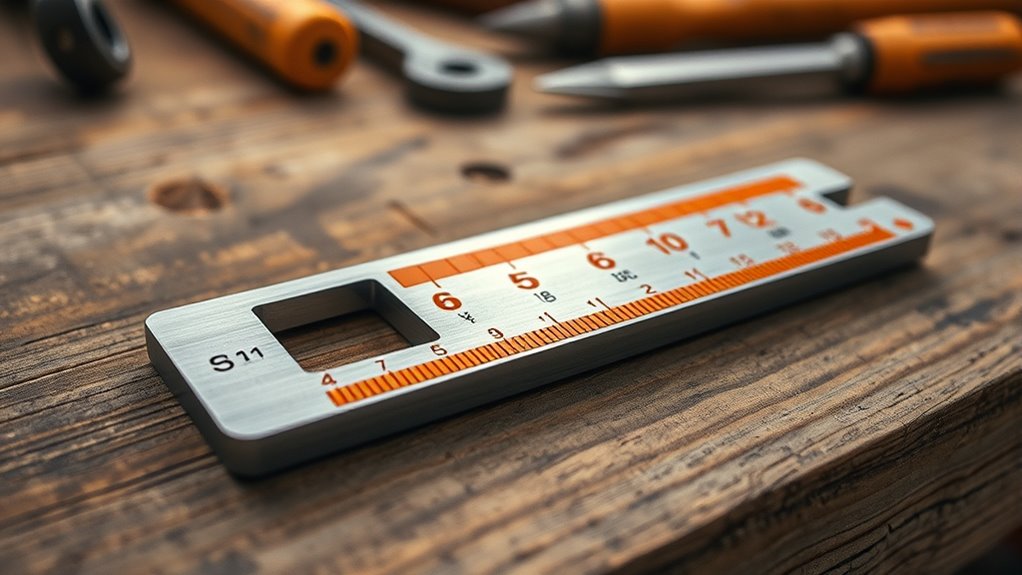Discover hidden tricks with your speed‑square that can boost your projects’ accuracy and speed. Use its built-in protractor for quick angle transfers, and utilize the scribe lines and notches for precise markings and repetitive cuts. The guides help locate stud centers effortlessly, while the notches assist in complex angle cuts. Mastering these features will elevate your craftsmanship and efficiency. Keep exploring—there’s always more to uncover to make your work even smoother.
Key Takeaways
- Use the built-in protractor to quickly transfer and measure complex angles beyond 90°, expanding your framing options.
- Utilize the notches and scribe lines for precise repetitive cuts and accurate stud center marking.
- Leverage the hidden guides to locate framing studs effortlessly without additional tools.
- Employ the square’s lip and built-in scriber for fast, accurate marking on tough materials like plywood or drywall.
- Combine the speed‑square with other tools to verify measurements and ensure perfect perpendicular and angle cuts.

Have you ever wondered how professionals achieve perfect angles quickly and accurately? The secret often lies in the humble speed‑square, a versatile tool that goes far beyond just marking right angles. While many beginners think of it as a simple carpenter’s square, seasoned experts know it can do so much more once you understand its hidden capabilities. If you’re just starting out, understanding how to maximize its uses can markedly improve your measuring accuracy and efficiency on any project.
One of the most overlooked aspects of the speed‑square is its ability to help you measure angles other than 90 degrees. With the built-in protractor scale, you can easily mark any angle between 0 and 90 degrees, which is incredibly useful for framing, roofing, or trim work. This feature allows you to quickly transfer angles from one piece to another without complicated calculations. As a beginner, your goal should be to familiarize yourself with these measurement tools and practice transferring angles accurately. Using the speed‑square as a guide, you can develop a sense of proportion and precision, leading to cleaner cuts and tighter fits.
Accuracy in measuring is vital, especially when you’re working on complex projects. The key to measuring accuracy with a speed‑square is to guarantee your tool is properly aligned before marking or cutting. Always check that the lip of the square sits flush against your workpiece, and don’t rush your measurements. Taking a moment to double-check your markings can save you time and material in the long run. For beginners, a good tip is to use a pencil with a fine tip to make clear, precise lines, and to verify your measurements with a combination square or ruler. Over time, these habits will become second nature, sharpening your ability to achieve perfect angles effortlessly. Additionally, understanding the importance of contrast ratio can help you select the right projector for viewing your projects clearly, especially in varying lighting conditions.
Beyond measuring and marking, the speed‑square is also excellent for layout work. You can use it to draw straight, perpendicular lines, or to establish consistent spacing for repeated cuts. Its built-in scriber makes marking easier and more accurate, especially on tough materials. Additionally, some models feature scribe lines and notches that help you cut repetitive angles or locate stud centers in framing. These hidden features are what make the speed‑square a true secret weapon for both beginners and pros.
Mastering these lesser-known uses takes practice, but once you get comfortable, you’ll find that the speed‑square becomes an indispensable part of your toolkit. Its ability to deliver quick, precise measurements and markings means you can work faster, with less guesswork. Whether you’re framing a wall, installing trim, or making custom cuts, understanding how to utilize all of its features will elevate your craftsmanship and give you confidence on every project. In the end, the more you explore and experiment with your speed‑square, the better your measurements and overall accuracy will become.
Frequently Asked Questions
Can Speed Squares Be Used for Measuring Angles Beyond 90 Degrees?
You might wonder if a speed square can measure angles beyond 90 degrees. While it’s primarily designed for right angles and basic angle measurement, you can use it for some advanced applications by marking and aligning different edges. However, for precise angle measurement beyond 90 degrees, a protractor or adjustable tool is better. Speed squares excel in quick, accurate angle measurement within their primary range, making them versatile for many construction tasks.
Are There Safety Tips for Handling Speed Squares During Prolonged Use?
They say safety is no accident, so always prioritize it. When handling speed squares for extended periods, practice ergonomic handling to prevent strain. Take regular breaks, and wear protective gear like gloves and safety glasses to avoid injuries. Keep your workspace organized to reduce accidents. Remember, your safety is the foundation of quality work—so stay alert, use proper techniques, and never rush.
How Does a Speed Square Compare to a Combination Square?
You might wonder how a speed square compares to a combination square. The speed square excels in construction versatility, making it ideal for marking angles and straight cuts quickly. It offers reliable measurement accuracy for framing and roofing. Unlike a combination square, which provides precise measurements and depth markings, the speed square is more portable and faster for quick tasks. Both tools are valuable, but your choice depends on your project’s specific needs.
Can a Speed Square Be Used for Marking Curves or Circles?
A speed square is like a Swiss Army knife for carpentry, but it’s not ideal for curved marking or circle drawing. While it’s great for straight cuts and angles, it lacks the flexibility needed for precise curves. For circle drawing, you’re better off with a compass or a flexible curve. The speed square’s rigidity makes it tough to accurately mark curves or circles, so don’t rely on it for those tasks.
What Are the Best Cleaning and Maintenance Practices for a Speed Square?
To keep your speed square in top shape, follow simple cleaning tips and maintenance routines. Wipe it down regularly with a damp cloth to remove dust and debris, avoiding harsh chemicals that could damage the surface. Check for loose or damaged parts and tighten or replace as needed. Store it in a dry, safe place to prevent rust and warping. Proper care guarantees your tool stays accurate and lasts longer.
Conclusion
Now that you know these unexpected Speed‑Square tricks, you’re ready to tackle projects with confidence. From quick measurements to creative uses, you’ve revealed a toolbox of secrets. Think of it as your own Swiss Army knife—versatile and essential. So, go ahead, wield your Speed‑Square like a true craftsman, and don’t forget, even Leonardo da Vinci would be impressed by your newfound skills. Happy building—your workshop just got a whole lot smarter!









